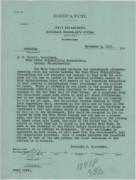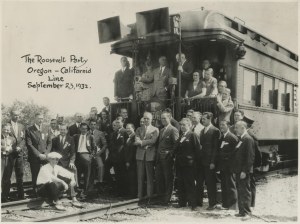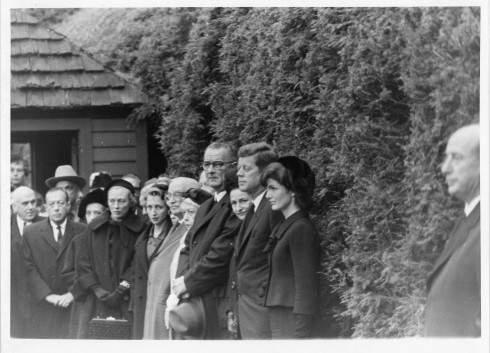 The ties between the Roosevelt and Kennedy families go back to World War I when Franklin D. Roosevelt was Assistant Secretary of the Navy. In November 1917, Joseph P. Kennedy was the Assistant General Manager of the Fore River Shipbuilding Corporation in Quincy, Massachusetts, when a labor strike threatened the company’s contribution to the Navy’s shipbuilding program. Assistant Secretary Roosevelt appealed to Fore River’s management and to the striking workers “to sink all minor differences and to get together for the sake of the success of our country in this war at once.” The strike ended a few days later.
The ties between the Roosevelt and Kennedy families go back to World War I when Franklin D. Roosevelt was Assistant Secretary of the Navy. In November 1917, Joseph P. Kennedy was the Assistant General Manager of the Fore River Shipbuilding Corporation in Quincy, Massachusetts, when a labor strike threatened the company’s contribution to the Navy’s shipbuilding program. Assistant Secretary Roosevelt appealed to Fore River’s management and to the striking workers “to sink all minor differences and to get together for the sake of the success of our country in this war at once.” The strike ended a few days later.
As New York Governor Franklin Roosevelt prepared to seek the Democratic Party’s nomination for president at the convention in Chicago in July 1932, Joseph P. Kennedy—now working in Hollywood and New York—lent his support to FDR, both financially and politically. Kennedy was one of those who were known as “WRBC”, or With Roosevelt Before Chicago. He donated to the campaign, met with Governor Roosevelt and his Brains Trust in Albany, and helped convince supporters of John Nance Garner to throw their delegates to Roosevelt at the convention. Kennedy continued to advise Roosevelt after he won the nomination, and in August Kennedy wrote to FDR: “As I told you over the phone unless they [the Republicans] can put two and one half million men back to work and get wheat up to twenty or twenty five cents a bushel the result will be overwhelming for Roosevelt.” Roosevelt even invited Kennedy along on the campaign train that fall.

As the New Deal began to take shape, one of FDR’s early reforms was the creation of the Securities and Exchange Commission. The SEC was designed to protect investors from fraudulent and unethical practices in the stock market. FDR began to assemble his choices for the five-person Commission, and Joseph Kennedy was selected to be the first chairman. As a June 15, 1934 memorandum indicates, FDR’s choice of Kennedy as chairman reflected the man’s “executive ability, knowledge of habits and customs of business to be regulated and ability to moderate different points of view…” Kennedy received a five year appointment, and although he resigned in September 1935 to return to private business, he received high praise for effectively working with both Washington and Wall Street to implement the new regulations.
Kennedy again supported FDR’s nomination for the presidency in 1936, and in 1937 returned to public service to become the first chairman of the newly created Maritime Commission that had been established to revitalize the United States shipping industry.  Then, in March 1938, Kennedy received the appointment he most wanted in Roosevelt’s government: Ambassador to the Court of St. James – the first Irish Catholic American to hold this prestigious diplomatic post. As the new U.S. Ambassador in London, Kennedy had a front row seat to the worsening international crisis in Europe. When war finally came in September 1939, Kennedy’s public support for American neutrality conflicted with Roosevelt’s increasing efforts to provide aid to Britain. Roosevelt and Kennedy met in October 1940 to try to iron out their differences, but it was clear the split could not be repaired. Kennedy resigned after FDR’s election to a Third Term in November.
Then, in March 1938, Kennedy received the appointment he most wanted in Roosevelt’s government: Ambassador to the Court of St. James – the first Irish Catholic American to hold this prestigious diplomatic post. As the new U.S. Ambassador in London, Kennedy had a front row seat to the worsening international crisis in Europe. When war finally came in September 1939, Kennedy’s public support for American neutrality conflicted with Roosevelt’s increasing efforts to provide aid to Britain. Roosevelt and Kennedy met in October 1940 to try to iron out their differences, but it was clear the split could not be repaired. Kennedy resigned after FDR’s election to a Third Term in November.
Despite their later policy differences, the ties between FDR and Joseph Kennedy extended to the next generation of Kennedys. In 1935, FDR learned that young Bobby Kennedy was a stamp collector and sent the boy some of stamps for his collection. In 1940, recent Harvard graduate John F. Kennedy sent an inscribed first edition of his recently published book, Why England Slept, to FDR for his book collection. As was his custom, FDR signed the flyleaf underneath Jack Kennedy’s signature. And in 1944, FDR was shocked to learn of the death of Joseph P. Kennedy, Jr., while on a combat bombing mission, and the President wrote a heartfelt condolence letter to the elder Joe Kennedy.
FDR’s own death in April 1945 brought an end to Joseph Kennedy’s years of collaboration with Franklin Roosevelt. But post-war America saw the rise of a new Kennedy to prominence, John F. Kennedy. As a leading figure in the Democratic Party, Eleanor Roosevelt saw JFK grow from a Congressman, to a United States Senator, then a potential nominee for vice president in 1956, and finally the Democratic Party’s nominee for president in 1960.

A longtime supporter of the liberal Adlai Stevenson’s runs for the presidency, Eleanor Roosevelt had concerns about JFK’s commitment to some of the liberal causes that she held dear. During the 1950s, ER challenged John Kennedy to be more vocal in his opposition to McCarthyism. And in 1960, Mrs. Roosevelt feared that JFK’s caution on civil rights issues was an attempt to garner votes in the more conservative southern states that might backfire and cost him votes in the more liberal north.
On August 14, 1960, Kennedy came to Hyde Park to pay his respects to Mrs. Roosevelt and to gain her full support for his candidacy. After visiting the Roosevelt Library and the FDR Home to deliver a speech commemorating the 25th anniversary of Social Security, JFK had tea with Mrs. Roosevelt at her Val-Kill home where they talked over the issues and his campaign. Following the meeting, Eleanor Roosevelt threw her full support behind the Kennedy-Johnson ticket.
 During the campaign, Mrs. Roosevelt never hesitated to give her advice to the young candidate, including commenting on the first televised presidential debates. After his election, President Kennedy appointed ER to be the chairperson of the President’s Commission on the Status of Women. Mrs. Roosevelt’s death on November 7, 1962 brought President and Mrs. Kennedy, as well as former presidents Harry Truman and Dwight Eisenhower and Vice President Lyndon Johnson to Hyde Park to attend the funeral and witness her burial in the Rose Garden next to Franklin D. Roosevelt on November 10, 1962. A little over a year later, JFK himself would be gone, bringing the curtain down on the collaboration of the Roosevelts and Kennedys that spanned more than a half a century.
During the campaign, Mrs. Roosevelt never hesitated to give her advice to the young candidate, including commenting on the first televised presidential debates. After his election, President Kennedy appointed ER to be the chairperson of the President’s Commission on the Status of Women. Mrs. Roosevelt’s death on November 7, 1962 brought President and Mrs. Kennedy, as well as former presidents Harry Truman and Dwight Eisenhower and Vice President Lyndon Johnson to Hyde Park to attend the funeral and witness her burial in the Rose Garden next to Franklin D. Roosevelt on November 10, 1962. A little over a year later, JFK himself would be gone, bringing the curtain down on the collaboration of the Roosevelts and Kennedys that spanned more than a half a century.


You must be logged in to post a comment.